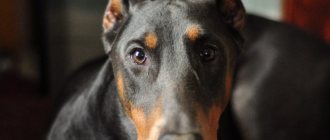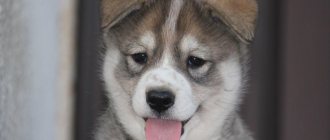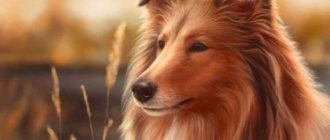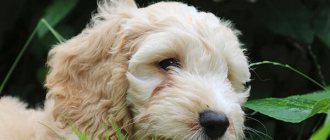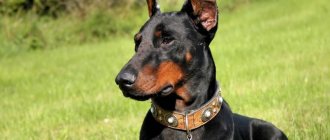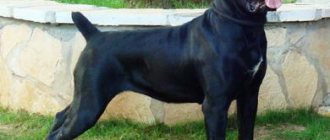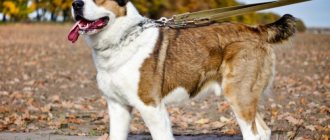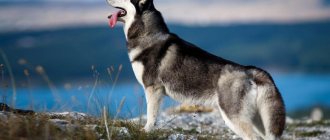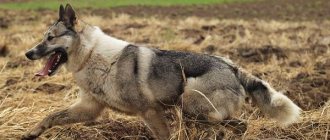| Origin | Russia |
| Usage | universal hunting dog, companion |
| Color | plain white, two-tone, reddish-brown of any shades, grey, fawn |
| Dimensions | 51-62 cm, 19-22 kg |
| Lifespan | 12 years |
The West Siberian Laika is the pride of Russian cynology. Only in harsh Siberia could such a hardy, reckless, sensible, people-loving hunting dog be born. It is not surprising that the breed is the most common among huskies.
Origin story
The West Siberian Laika (WSL) originated in the forests of Northeastern and Western Siberia. The origin of the breed is closely related to the indigenous population of the Khanty-Mansiysk Autonomous Okrug. Since the times of Tsarist Russia, taiga hunters have crossed outsider wolves and used their descendants for hunting.
The result was a hardy, strong breed with a strong hunting instinct. It was divided into 2 types depending on the region of breeding:
- Vogul Laika or Mansi;
- Ostyak, also Khanty Laika.
The Russian Siberian Laika breed has 4 factory and 3 native varieties. ZSLs differ from other types in their greater endurance, taller stature, and focus on people.
The first description of the breed was published in 1925. At that time, the classification of Russian huskies was confusing, and the Mansi and Khanty representatives were divided into separate subspecies.
In 1947, the varieties were combined, and by order of I. Stalin, breeding of huskies began. The breed was bred in more than 50 nurseries in Russia. The best breeding centers were located in the Sverdlovsk, Moscow, Novosibirsk, and Perm regions.
Breeders created strong dogs devoid of genetic defects. To do this, they used outcrossing - crossing pets of the same type without family ties. The first sires were Grozny, his grandchildren Norai, Taezhny, Muks in the Sverdlovsk breeding line, and Mishka, Ulf, Sever in the Moscow line.
Over the course of ten years, the breed type was fully formed, while the breeders retained the original features of the Mansi and Khanty dogs. In addition to their blood, West Siberian huskies inherited the genotypes of Nenets, Ural, Zyryansky huskies, German shepherds and dingoes.
A new description dividing dogs according to geography was approved in 1954. West Siberian huskies began to conquer Europe in the 60-70s. And 10 years later, in 1980, the International Canine Federation (FCI) recognized the breed and adopted a standard.
Standard requirements
The West Siberian Laika is a medium-sized breed. Its exterior is powerful, durable, but without massiveness. The dog moves easily, when walking - at a short trot, when running - at a trot combined with a gallop.
Males are more courageous, larger and rougher than females. They also have longer hair at the withers. The difference is visible to the naked eye in the photographs.
| Parameter | FCI breed standard No. 306 dated October 13, 2010 |
| Height | 55-62 cm – male, 51-58 cm – female. |
| Weight | 19-22 kg. |
| Body type | Strong, without meatiness or roughness. The skin is thick, without folds or looseness. |
| Frame | Stretched, longer than the height at the withers, more elongated in bitches. The back is straight, slightly inclined from the withers to the croup (the difference in height is 1-2 cm). The chest is deep and wide, in contact with the elbows, the stomach is lean, the underline is smooth. |
| Head | Dry, with pronounced muscles. Elongated, wedge-shaped. The length of the skull is half its width. |
| Nose | Medium size. The lobe is black; in white dogs, brown pigmentation is allowed. |
| Ears | Small, V-shaped, standing high. The tips are pointed. |
| Eyes | Oval, deep set. The iris is brown, matching the color. |
| Bite | Scissor-shaped. |
| Tail | Rolled into a ring, thrown over the back - straight or slightly to one side. Long - if straightened, it will reach the hock joints. |
| Limbs | Straight, parallel, with defined muscles. Set wide apart, elbows point back and touch the chest. The length of the front legs from the ground to the elbow exceeds ½ of the height at the withers. |
| Paws | Oval, gathered into a ball, the middle fingers protrude slightly forward. The hind legs are smaller than the front legs. |
| Wool | The guard hair is coarse, straight, dense, the undercoat is abundant and soft. A collar is formed on the neck and shoulders, sideburns on the cheekbones, and panties on the hips. At the back of the limbs and at the bottom of the tail the hair is longer, but without fringes; on the head it is short and dense. The hairs between the toes are tough and protect the pads from damage. |
| Color | Acceptable colors: pure white, brown-red of any shade or in combination with the main gray or red color, deer (red), two-color - spots of any of the indicated colors are located on a white background. |
Disqualifying faults
The dog is removed from the ring for:
- psychological deviations - cowardice, aggression towards people;
- bite other than scissor bite;
- speckled iris, cloudy cornea;
- drooping or not fully erect ears;
- saber-shaped tail, shortened, hanging, with dewlaps;
- excessively short or long hair;
- albinism, brown, blue, brindle colors.
ZSLs are also fined for other shortcomings. The degree of punishment is determined based on the severity of the defect and its impact on the dog’s health:
- light pigmentation of eyelids, nose, lips;
- deviations from the permissible height by 2 cm up or down;
- sagging or arched back;
- curly, wavy, soft wool;
- black color - pure or in combination with white;
- cryptorchidism.
Judges closely evaluate the size of West Siberian huskies. There is a tendency for the breed to become larger. Thus, the standard was repeatedly revised, and the growth parameters changed: until 1966, the lower height limit for males was 52 cm (today 54 cm), for females - 50 cm (now 51 cm). But many males go even beyond these boundaries - there are dogs from 63 to 69 cm at the withers.
Breed differences between West Siberian huskies
Although the West Siberian huskies of the Mansi and Khanty varieties are combined into one breed and are similar to each other in hunting manners, character and origin, cynologists still distinguish 2 types. They really differ in appearance.
The Mansi type has:
- narrow head;
- long, elongated muzzle;
- smooth transition from head to muzzle;
- lean, lightweight physique;
- round eyes;
- hare-type paws.
The Khanty type is different:
- shorter muzzle;
- pronounced stop;
- wide forehead;
- abundant decorating collar on the neck and shoulders;
- slanted eyes;
- a well-built, strong constitution;
- "cat's" paws.
Both types of Western Laika are of breeding value. Preservation of varieties and improvement of their best breed traits are the priority tasks of breeders.
Varieties of color
The following colors are allowed by the standard:
- zonal gray;
- zone-red;
- grey;
- ginger;
- fawn and reddish-brown of all shades;
- pure white or two-color (piebald), that is, white with spots of any color listed above and similar to the main color.
Temperament
The character of West Siberian huskies is complex. Their behavior and manners are similar to their closest relatives - wolves. The only difference is friendliness and dependence on the person.
The West Siberian Laika is an independent dog. She always evaluates the situation: in difficult circumstances, the pet would rather act as her instincts dictate than listen to her owner’s commands.
ZSL has very strong instincts. This makes dogs natural hunters who can survive for weeks in the deep forest.
At the same time, West Siberian huskies are more attached to people than other breeds in this group. They need their owner's attention and approval. They are open, active, and temperamental.
Dogs love to communicate: barking for them is not just a way of expressing emotions, but a means of communication. Rarely does a minute in the company of pets go by without ringing, loud barking.
Diseases
Laikas are distinguished by good health. This is due to the careful selection, because only physically strong dogs can benefit the hunter.
Among the most common diseases in huskies are:
- diabetes;
- renal failure;
- deafness
- glaucoma
- retinal atrophy;
- bloating;
- hip dysplasia.
Application
The West Siberian Laika is a universal hunter. She can spend hours following a squirrel in the dense crowns of trees and bravely fight a bear.
With the help of these hardy dogs they go to:
- wild boars, deer, roe deer, elk;
- bears;
- fur animals;
- game birds;
- burrowing animals.
Dogs are excellent at tracking, chasing and holding any game. The dogs have developed lower and upper senses, they are able to follow the old trail, and are equally good at single, pair, and roundup hunting.
The West Siberian Laika has good sociable qualities. But this does not mean that the pet will happily walk around at picnics and carry balls like a golden retriever. First of all, he is a hunter. And by partner traits we mean a focus on a person. Among other Siberian huskies, ZS is the least adventurous. She does not lose contact with her owner during the hunt, and is distracted from her prey on command.
The characteristics of the breed include expressed anger towards the beast, but not towards humans. The West Siberian Laika is wary of strangers, but does not care about property. If she copes with the role of a security guard with varying degrees of success, then she will not become a security guard.
Purpose of huskies
The amazing hunting instincts of northern dogs are genetically determined. The dog's goal is to track and bark at game. She must indicate the location of the beast, distract her from the hunter.
Dogs have an excellent sense of smell and a loud bark; they can track animals even after 12 hours; they also work in a team, for example, to hunt a bear.
The pet shows its best hunting skills:
- for small game - quickly finds and bites the neck, but does not damage the skin;
- on a squirrel or sable - covers vast territories and informs the hunter with a loud bark;
- on a capercaillie or hazel grouse - it almost sneaks, and when it gets close, it barks, indicating the place of the bird;
- for waterfowl - the dog walks alongside, carefully sniffs the scent of the bird, after shooting, rushes into the water and delivers it to the owner;
- at a bear - first it barks when the predator tries to leave, bites painfully on the legs, showing miracles of resourcefulness and speed of reaction.
Socialization
It is impossible to house other animals in a house where huskies live. Dogs rarely get along with cats, and only if they grow up with them from puppyhood. However, they will not be friends with mustaches.
Other people's pets are legal prey for West Siberian huskies. They pursue them with passion. On walks, dogs are not allowed off a leash: they can kill a neighbor’s favorite cat or get lost while chasing a pigeon.
Relations with other breeds are tense and polite. But rarely does anyone risk having two West Siberian husky males. Every minute skirmishes and struggle for supremacy are guaranteed.
At the same time, pets are not dominant towards people. They view them favorably as intelligent but physically weak partners. Dogs form a tandem with humans, based on respect and cooperation.
West Siberian Laikas are reserved with children. They take the position of a patron and patiently endure pranks. But the child is not an authority for them; the pets will not obey him.
How to choose?
Naturally, it is better to purchase a puppy from a professional breeder . This way you can be absolutely sure of the purebred dog.
NOTE!
The breeder also has all the necessary information about the puppy’s parents, their merits, the results of testing for genetic diseases, vaccinations, etc.
An experienced breeder will tell you which puppy is suitable for a particular person. Most often, active and curious puppies are recommended for active people, while calmer and more reasonable puppies are recommended for phlegmatic people.
This is a companion dog, so the lifestyle of her and her owner should match.
In appearance, puppies should be healthy, with fluffy fur and a natural shine. Eyes and ears are clean, without unnecessary odors. The front and rear paws are parallel, straight and not facing in different directions.
The puppy must move freely . The ears may still be lying down.
Samoyed husky puppies are unpretentious in care and maintenance. They get along easily with any animals and children. Even a beginner in dog breeding can get a dog of this breed. The main thing is to love the dog and it will reciprocate.
Upbringing
The West Siberian Laika is a stubborn, wayward dog with its own opinion. She will certainly demonstrate all these qualities during training. And that's okay. Such traits are inherent in hunting breeds; they help dogs pursue prey and make independent decisions. Therefore, the training of the guard is conditional. The main thing is that the West Siberian Laika learns the commands of prohibition, calling and restraint. And at least with a delay she fulfilled them.
If you train a dog, it will stop assessing situations independently and will become completely dependent on its owner. The situation will play a cruel joke - when hunting, instead of trusting its instincts and acting instantly, the pet will wait for the person’s order. Due to such delays, at best, she will miss the prey, at worst, she will suffer from the claws, teeth and hooves of wild animals.
Keep in mind that hunting is dangerous for the dog itself. Therefore, trained dogs that have already been used as decoys are released into the forest.
The general training course (GTC) lasts up to 8-10 months. From the age of 5 months, West Siberian huskies are introduced to the forest, accustomed to its smells, sounds, and behavior in the thicket. The first training is carried out from 10-12 months.
It is important that the West Siberian Laika begins hunting before the age of 2 years. Otherwise, she won’t turn out to be a hunter.
Maintenance and care
There are pros and cons to keeping West Siberian Laikas. On the one hand, dogs are unpretentious. On the other hand, they need special conditions.
It is better to keep West Siberian Laikas in a spacious house away from civilization and closer to the forest. They are housed in an enclosure with an insulated kennel and a sun canopy. Dogs need space, freedom and the opportunity to constantly express their inexhaustible energy.
The West Siberian Laika adapts poorly to urban conditions. Still, she will get along in an apartment with a daily long walk and trips to nature at least once a week.
Hygiene
The West Siberian Laika is a native breed, its appearance is formed naturally. To maintain natural beauty, no special care is needed.
You will need:
- comb once a week, during molting - every day;
- bathe when soiled - approximately once a season;
- trim nails if they do not grind down on their own;
- examine your eyes and ears every day, clean them as they become dirty;
- After walks, check the paws - the pads are often injured.
They also take care of the cleanliness of the sleeping area. The lounger is washed every week, if instead there is a straw bedding, it is changed with the same frequency. Feces are removed from the enclosure every day, and it is disinfected once a month.
Walk
West Siberian huskies are endlessly hardy dogs. They are literally tireless - even after hours of hunting, a bowl of meat and a ten-minute break are enough for them to regain strength.
Therefore, you will have to walk with your pet often and a lot. She is taken outside at least twice a day for 1-1.5 hours. It is advisable to go to the forest at least once a week. And, of course, hunt with a dog.
The West Siberian Laika, due to insufficient physical activity, develops aggression, apathy, and destructive tendencies. The lack of exercise is also reflected in their appearance - without hunting and walking in the forest, dogs gain excess weight and lose hair.
Feeding
The West Siberian Laika has a digestive tract similar to that of wolves. Therefore, the best choice is natural food rather than ready-made food.
The menu for Laika consists of:
- lean meat - they do not give steaks or fillets, but trimmings, goulash, tenderloins with cartilage, sinew, etc.;
- offal: heart, udder, lungs, tripe, and occasionally liver;
- ocean fish;
- vegetables and fruits;
- fermented milk products;
- cereals - rice, buckwheat, wheat, barley, for puppies - oatmeal.
Meat, offal and fruit are given raw; fish must be boiled and boned. Vegetables are fed raw, boiled, stewed, cereals are boiled. The diet also periodically includes vegetable oils, bran, eggs, delicacies, and greens.
Natural nutrition is difficult to balance. Therefore, mineral and vitamin supplements must be administered. The veterinarian will tell you which ones a particular dog needs.
It is not advisable to feed your pet before going into the forest: a well-fed dog is not a hunter.
The West Siberian huskies have an “iron” stomach. They will digest anything, are able to go hungry for a long time and eat spoiled meat without any problems. But this does not mean that pets need to be fed substandard food. Yes, if a dog eats missing or inappropriate food a couple of times, nothing will happen to it. But systematic improper feeding will undermine the health of the hardiest dog.
Health
The West Siberian Laika is an exceptionally healthy breed. She is genetically pure, without hereditary defects, and not susceptible to injury. All pathologies in dogs appear due to negligence or poor care.
When people say that their wounds “heal like dogs,” they mean West Siberian Laikas. Dogs easily endure severe injuries, and minor injuries heal within a few days.
Huskies live on average 12 years. But some dogs lived up to their 16th birthday.
Preventive measures
No matter how healthy the breed is, preventive measures are mandatory. Since the West Siberian Laika is often found in the forest and comes into contact with wild animals, you need to:
- treat the fur coat from blood-sucking parasites;
- from spring to autumn, use a collar against fleas, ticks, and lice;
- give deworming medications monthly;
- Be sure to vaccinate against rabies and canine distemper.
Of the remaining vaccines, serums are recommended for herpes, parvovirus, parainfluenza, adenovirus, leptospirosis, and hepatitis.
Development by months
ZSL puppies grow quickly. In just a year they reach the size of an adult dog. Therefore, the first 12 months are critical. At this time, it is necessary to monitor the height and weight of the dogs, make sure that they gain sufficient weight, but do not overeat.
The size of the puppies depends on their age. The table will help you navigate. If in doubt, you can look at the photos - they show what healthy, moderately well-fed kittens look like.
| Month | Males (weight in kg) | Bitches (weight in kg) | Males (height in cm) | Females (height in cm) |
| 1 | 2,25 | 2,05 | 29 | 25 |
| 2 | 5,5 | 4,5 | 37 | 34 |
| 3 | 8,7 | 7,5 | 43 | 40 |
| 4 | 11,4 | 10 | 48 | 46 |
| 5 | 15,2 | 13,2 | 53 | 50 |
| 6 | 16,2 | 15,3 | 56 | 53 |
| 7 | 17 | 16,2 | 58 | 54 |
| 8 | 18,9 | 17 | 59 | 55 |
| 9 | 19,9 | 19 | 60 | 55 |
| 10 | 20 | 19,5 | 60 | 56 |
| 11 | 20,8 | The weight of an adult husky does not change | 60 | 56 |
| 12 | 21,2 | 61 | 57 |
Average values are shown. The upper and lower limits of the norm vary - +/- 2 cm of height and 0.5-1 kg of weight are acceptable.
Breed Features
Previously, they were called exclusively “northern wits.” It was the sharp ears that clearly distinguished this dog from the dog tribe. Laika is a kind of prototype of the Spitz; as a separate species, it became of interest to dog handlers only in the 19th century. However, many difficulties arose in the classification, since the diversity of animals was amazing - so many nationalities, so many varieties. Nevertheless, the result was summed up: the breed was divided into two main groups. This division was literally correlated with geography. The main standards were announced only in 1952.
To what age do they grow?
The puppy begins to grow up very early, and by 18 months it turns into a full-fledged adult dog. This period is enough for adaptation, education and study, which is carried out in several stages “from simple to complex.” However, it is sometimes too early to talk about final maturity at 18 months. A large individual can grow up to 3-4 years, which depends on the species to which it belongs.
The husky matures gradually, overcoming several periods:
- neonatal - the period of infancy, when the puppy needs warmth and good nutrition, it lasts until the 12th day;
- transitional - a period of obvious physiological changes: the eyes open, the first teeth appear, the puppy stands on its paws and begins to move, lasts until the 20th day from the moment of birth;
- the period of understanding - when the puppy begins to feel like a part of the world, a very important period, at this moment the psyche is formed, separation from the mother at this time is unacceptable, lasts until the 28th day from the moment of birth;
- socialization - the period when the puppy becomes a dog, subject to the necessary discipline, it lasts until the 7th week from birth;
- “human” socialization - the period when a connection with a person is established, the most favorable for introduction to the future home, corresponds to 7 - 12 weeks from the moment of birth;
- the period of exposure to fear - the period when the baby is very timid, afraid of everything new, special attention is required here (for example, when visiting a veterinary clinic), lasts from the 8th to the 11th week from the moment of birth;
- “Age of Reduction” is a period of reduction in dependence, which coincides with a reduction in the number of teeth, at this time the puppy decides for itself the issue of leadership, the duration of the period is 13-16 weeks;
- instinct of “flight” - the period of teething, when the puppy tries to feel completely free, the period is characterized by unpredictable actions, disobedience, it lasts about 4 months, at the age of 4 to 8 months;
- the second period of exposure to fear is another moment of growing up, fear of uncertainty, during this period patience and wisdom are required from the owner, the period occurs between 6 and 14 months;
- By 18 months, the puppy is fully formed, but does not stop growing, as mentioned above.
We advise you to read: Where to buy a dog inexpensively and how not to make a mistake.
Mating
West Siberian huskies mature early. Estrus (first heat) occurs from six months to a year. But dogs are not bred that early. The optimal start for mating is from 15 months for males, from 18 months for females.
Only healthy, purebred dogs are allowed for breeding. The rest are discarded.
Pregnancy lasts 53-71 days and is easy. Dogs give birth on their own; caesarean sections are rarely performed. There are an average of 4-5 puppies in a litter.
What you need to know before buying puppies
The West Siberian Laika is a working dog. She is bred for hunting, not for exhibitions. Therefore, the first piece of advice on how to choose a kitten is to find a breeder-hunter.
Hunters keep working stock. And since the puppy’s character and qualities depend on its parents, 90% of the traits of its mother and father will be passed on to it. Moreover, profit is not the first priority for such breeders, so they themselves will tell future owners if some of the dogs have shortcomings.
Initially, you can get acquainted with the litter by looking at photos of the puppies. But it’s better to finally decide which kitten to take after meeting the kids in person. Need to see:
- what the puppy and its parents look like;
- conditions for keeping dogs;
- permission for breeding, pedigrees, certificates of males and females about victories in exhibitions - the latter must be with working tests.
If this is your first hunting dog, it is worth taking with you someone familiar with the breed. He will appreciate the exterior and character of the carousing.
Photo
In this article you got acquainted with the amazing Laika breed, photos of which are presented in the gallery above. A hardy hunter, a devoted friend and companion, this dog is able to grace any owner with its daily presence.
How much do puppies cost?
The price of the West Siberian Laika breed is low. Advertisements for sale can be found from 5-7 thousand rubles.
But such proposals are voiced by dog lovers. In breeding nurseries, a kitten costs more - from 10-15 thousand. And this is a pet class. A puppy of breeding class is sold for 20-30 thousand rubles. And for show class they will ask from 50,000 rubles.
The West Siberian Laika is a rare breed whose low price does not always mean that the dog is sick or has defects. Puppies are often sold by ordinary hunters who simply want to give away the puppies for a symbolic few thousand.
Nurseries
Those who do not want to take risks and buy a puppy from their own hands turn to breeding nurseries. The best breeders are considered to be owners from the breed’s small homeland – Siberia. Therefore, it is better to look for a West Siberian husky kitten there.
Below are the largest nurseries in the Russian Federation. On their websites you can see pedigrees, photos of West Siberian Laikas, and order a puppy:
- https://www.laiki-pitomnik.ru - breeder of Russian-European, East and West Siberian huskies in Moscow, sells kittens for 10-20 thousand rubles;
- https://laika-72.ru/services/ – Tyumen nursery “Siberian Hunt”, breeds ZSL, huskies, Russian-European huskies;
- https://bestlaika.ru/o-pitomnike: breeder from Omsk, in the Vereteno kennel there are over 50 breeding dogs, all of them working lines.
The West Siberian Laika was created for chasing and driving wild animals. Only hunters should get one - a dog that does not constantly realize its instincts will wither away.
What vaccinations are needed?
Vaccinations are given by a veterinarian in the clinic or called to your home.
Anthelmintic drugs are given 10 days before vaccination . The puppy must be healthy.
It is recommended to use vaccinations from such manufacturers as MERIAL (Eurikan, PrimoDog), INTERVET (Nobivak), Fort Dodge Animal Health (Duramune MAX). The latter is the most modern and safe vaccine.
Vaccinations are given according to the following schedule:
- first - at 6 weeks
- second - at 8 weeks
- third - at 12 weeks
- simultaneously with the third or after 2 weeks rabies vaccination
- Vaccinate annually against leptospirosis, plague and rabies.
We must not forget about the anthelmintic before vaccination, otherwise the vaccinations will need to be repeated again.
